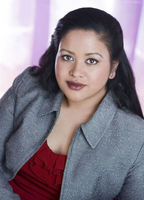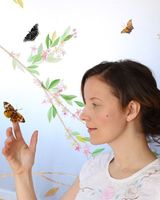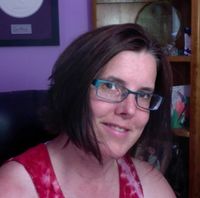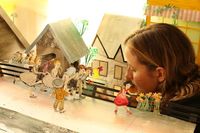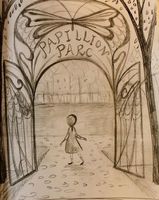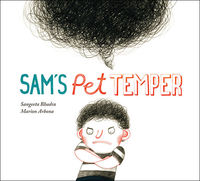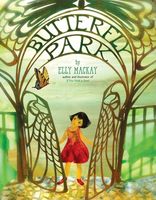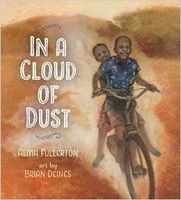Kid Lit Can, with Susan Hughes: Spotlight on 3 Picture Book Creators (2016 Blue Spruce Award Nominees), (Part 2)
By Susan Hughes & Submitted by kateburgess
Welcome! Today I continue my chat with the three accomplished creators whose picture books have been nominated for the Ontario Library Association 2016 Blue Spruce Award: Sangeeta Bhadra, Elly MacKay and Alma Fullerton.
Enjoy—and if you have any questions of your own, please add them to the comments section below.
Sangeeta Bhadra lives in Brampton, Ontario. Sam’s Pet Temper is her first picture book. Her Temper is kept leashed and muzzled in public and is generally well controlled the rest of the time, too!
Elly MacKay is a paper artist and children’s book author. She lives in an old Victorian house in Owen Sound, Ontario. Her website is www.ellymackay.com.
Alma Fullerton struggled with reading as a child until she realized she had dyslexia. By grade nine Alma loved reading. An award-winning author and illustrator Alma lives in Midland, Ontario. Her website is www.almafullerton.com.
Susan Hughes:
Can you each please tell me about your daily lives as creators?
Sangeeta Bhadra:
I remember reading tips about writing by Roald Dahl when I was a kid, and I know it has been said by many successful writers that one needs to set aside time for writing every day, but I’m afraid I’m not a person who does well with too much structure...the whole artist complex thing, I guess! I tend to work in spurts. I can go for several weeks without writing anything other than grocery lists, then sit down and work uninterrupted—coffee breaks permitted!—for two weeks straight. Odd, huh?
Your CanLit News
Subscribe to Open Book’s newsletter to get local book events, literary content, writing tips, and more in your inbox
Elly MacKay:
My life is chaotic at times but fulfilling and getting easier now. I have 2 kids—a 3 and a 7 year old—and when they go off to school I head up to the studio. It’s bright and sunny, and it’s up in the attic of our old Victorian home. Working from home has its challenges but having my own space has really improved things. In our old home, the kitchen table was used for everything. Here, I use the attic for preparing prints, computer work, writing, illustration and other photography experiments. I usually work on the computer for an hour catching up on emails, then dive in to the creating!
When 3:30 rolls around I pick up my kids. We visit with friends, go to Kung Fu, swimming or choir, make dinner and read stories until 8:00. Then if I have a deadline, I’ll work after they are asleep. I think having defined times and space for work and home-life really helps.
Alma Fullerton:
I get up and start working at about 7:00am every day. For the first 2 or 4 hours I answer emails and do things for the Society of Children’s Writers and Illustrators. I am the regional advisor for Canada East so I need to take care of things in my chapter. Some days this takes up a lot more time depending on what we have going on.
In the afternoon, I try to write for at least 3 hours and paint or illustrate for an hour or two, although this varies depending on deadlines or commissions. I am usually still working on something at 11:30pm.
People wonder why writers/illustrators are touchy when they are told writing isn’t a real job! It’s true that we don’t have the 40-hours-a-week 9-to-5 job. In fact, we work MUCH longer than that and often don’t get holidays!
SH:
What do you each enjoy most about writing for young children?
SB:
The chance to be funny and just a little bit silly, too. Humour is essential to writing for kids, and it’s great to have a reason to indulge.
EM:
I like every aspect of it. It’s so playful. I am always thinking about concepts for books. It makes the world more enjoyable to me—and helps me notice the small things in life too. Crafting the story, figuring out the details, the characters and the setting, and imagining the possible images is a fun process. Then I enjoy getting out of my head and working with an editor, and sharing the idea with friends and my kids. AND once your book is finished, you get to read it to children. What could be a better job?!
AF:
I love school visits and being able to interact with children. I love being able to enrich their minds and get them interested in reading and the world around them. I never want to write an "adult" book because I don’t feel they are important enough. I’m not saying they aren’t good—I’m saying if we don’t get children reading when they are young they aren’t going read the adult books when they grow up.
SH:
What challenges you most when you write for young children?
SB:
As much as I’m writing to please myself first, it’s challenging to remember that I’m also writing for young children and must keep the humour, references and so on at a level which they can comprehend and relate to.
EM:
The process of crafting a book can be like working on a difficult puzzle. Children’s books seem so simple but you have to work through so many ideas to get to the simplicity. It isn’t always clear which ideas will work or lead you in the right direction. Right now I am working on a book about clouds and the story seems just as nebulous as the subject. It is fun to explore all of the possibilities so long as you have the time. For example, my little boy was home sick today, so we sat together doodling. It was a good way to work through some of the ideas. My kids like to help and give me pretty honest responses.
AF:
The most challenging thing would probably be telling a full story in about 300 words or less while keeping it interesting and NOT writing down to children.
SH:
What is some advice that you’d give to writers or illustrators—beginning or experienced—who are working on their first draft of a picture book?
SB:
Don’t write down to children! And it’s not necessary to be overly cutesy. Just write an appealing story, then hope that they’ll like it!
EM:
I have some thoughts for illustrators that are considering authoring their own books. Previously, I would write a story, divide it up into 32 pages and then figure out the images. After coming up with an outline for a wordless book I realized that creating a sequence of images to tell a story was a much better method for me to use. Drawing, and then writing in bullet form beside the thumbnail, frees me from getting stuck on the text and helps me to pace the story.
AF:
Keep writing. READ as much as you can in the genre you are writing. Learn as much as you can about writing for children. Don’t write down to children. Don’t try to drill a "lesson" into your story. You will get rejections but keep writing, keep submitting and DON’T give up.
SH:
Can you tell me about any stories you’re working on at the moment?
SB:
Well, I’ve got a charming picture book in the works. It’s about the blossoming friendship between a hedgehog and an owl. I am really in love with it!
EM:
I feel really lucky to have worked on two books which come out next spring. The first is Maya (Owlkids) by Mahak Jain. It is a beautiful story—and it will make you cry. The other is called Beach Baby (Orca). It is a board book set at the seaside, full of pelicans, dolphins and other ocean life. The words are a gentle lullaby by Laurie Elmquist.
AF:
I have two picture books forthcoming: Hand Over Hand (Second Story Press, spring 2016) and When the Rain Comes (Pajama Press, fall 2016).
The views expressed by Open Book columnists are those held by the authors and do not necessarily reflect the views of Open Book.
Susan Hughes is an award-winning author of children's books — both fiction and non-fiction — including The Island Horse, Off to Class, Case Closed?, No Girls Allowed and Earth to Audrey. She is also an editor, journalist and manuscript evaluator. Susan lives in Toronto. Visit her website, www.susanhughes.ca.
